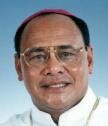|
His Excellency
e-mail: bayombongchancery@yahoo.com.ph |
||
|
The first Christian mission established in Nueva Vizcaya was that of Ituy in 1609. This sitio or barrio could have been anywhere between what is now the province of Cagayan in the north, and the mountains bordering Nueva Ecija in the south, because as the Spaniards colonized the Philippines, the entire Cagayan Valley, now Region III, was simply one province called Cagayan. The faith spread over the region through the efforts of the Augustinian and Dominican missionaries who came from areas now called Cagayan and Pangasinan. By 1717, Father Alejandro Cacho went on mission trips to Ituy, and slowly picked up once again whatever threads of Christianity had been left by the earlier missionaries. Within twenty years, with the help of the Augustinians, Father Cacho was able to baptize many Isinays and Ilongots, original inhabitants of the place, and build cogon chapels in some eight settlements in the Marang Valley. Over the years the settlements grew in number. Bujay, now the town of Aritao, and Dupax already had their resident priests. In 1739, Holy Mass was celebrated in Bayombong for the first time. The parishes of Bayombong, Bagbag and Dupax were established in 1741, and that of Solano soon after. In April of 1841 the province of Nueva Vizcaya was born, created as a politico-military province by royal decree from Spain. The original line dividing the valley into two – Cagayan and Nueva Ecija provinces – ran between Tumauini and Ilagan (now the capital of Isabela). The name Nueva Vizcaya came from that of a province in Spain called Vizcaya. The capital was the town of Camarag (now Echague in Isabela). In 1856, the province of Isabela was created, deriving half of its land from Cagayan, and half from Nueva Vizcaya. With this new partition, Bayombong became the new capital of Nueva Vizcaya. Nueva Vizcaya is the southernmost province of the Cagayan Valley Region, separated from Nueva Ecija and the rest of Luzon southward by the Caraballo Mountains. Landlocked by six provinces – Benguet, Ifugao, Quezon, Isabela, Nueva Ecija and Pangasinan – it is rugged in terrain but stands protected from storms by its mountains. The majestic Cagayan River, which winds through the entire Cagayan Valley and empties into the Babuyan Channel on the north of Luzon, starts from Nueva Vizcaya. |
||||
|
On November 7, 1966, the Prelature of Bayombong was established. In 1972 Quirino was made a separate province. The prelature then comprised the civil provinces of Nueva Vizcaya and Quirino. It had a land area of 6,961 square kilometers. On November 18, 1966, Monsignor Alberto Van Overbeke, CICM, was appointed prelate and installed as such. In 1969 he was appointed Bishop-Prelate Ordinary, and ordained bishop in the same year. On November 15, 1982, the prelature was elevated to a diocese, with Bishop Van Overbeke in charge. Because of ill health he asked for assistance and was given a coadjutor-bishop with the right of succession, in the person of Monsignor Ramon Villena. In 1987 Bishop Van Overbeke died and Bishop Ramon Villena became his successor. Economically, Nueva Vizcaya has always been timber country, logging operations having been its one heavy industry. Food crops – palay, tabacco, coconut, bananas and camote – are raised only for local consumption. Its large municipal centers are Bayombong, Solano and Bambang, where almost a third of the entire population of the province resides. There are also a number of minority groups living on its mountain boundaries. The Diocese of Bayombong today still comprises the civil provinces of Nueva Vizcaya and Quirino, and is a suffragan of the Archdiocese of Tuguegarao. It covers a population of 450,896 of which 70 per cent are Catholics. Its titular patron is St. Dominic de Guzman, whose feast is celebrated in the diocese every first Sunday of August. The diocese now has 3 vicariates over its 2 districts, looking after 17 parishes, 146 chapels, visitas and missions. Among the church personnel are 25 priests and 24 religious sisters. Among its organizations are the Apostleship of Prayer, the Catholic Women's League, the League of the Sacred Heart, Knights of Columbus. |
||||
The Catholic Bishops' Conference of the Philippines
The Official Website of
CBCP Online


Diocese of Bayombong
